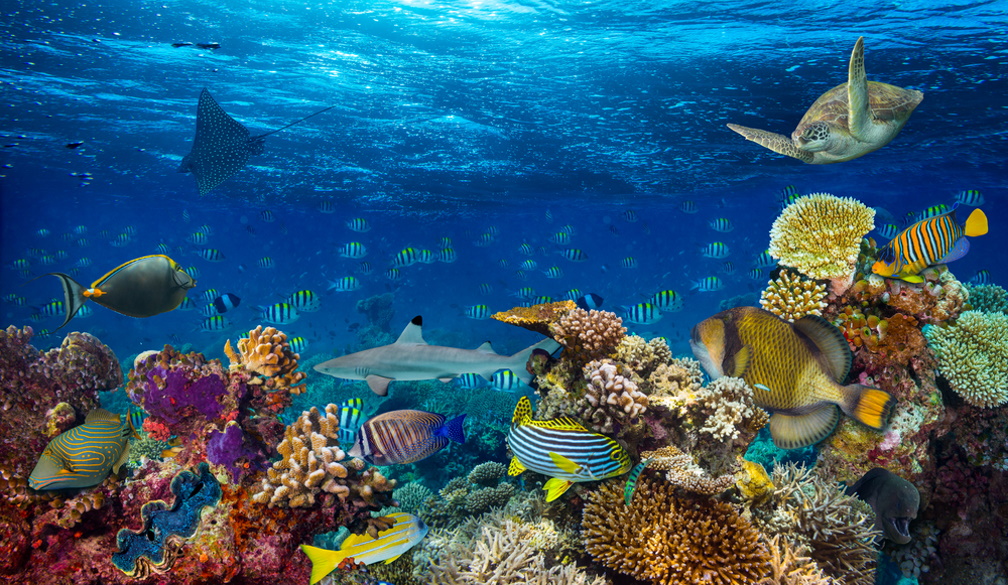What wildlife can you see on the Ningaloo Reef?

The Ningaloo Reef is something special. The world’s largest fringing reef, it covers 5000 square kilometres of the ocean. Its massive size means it’s home to a huge range of marine life, including hundreds of different fish and coral species.
It also sees some larger animal friends, like manta rays, dolphins, and sea turtles, and is also one of the few places in the world that sees whale sharks come together in such large numbers - and that is truly something to behold!
Let’s break down the wildlife you might catch a glimpse of when you visit the Ningaloo Reef.
Whale sharks
We’ve gotta start with the main event, and that’s whale sharks. Tourists from near and far flock to Exmouth to see whale sharks on the Ningaloo Reef during whale shark season, taking place from March to early August every year. The best way to catch a glimpse of these gentle giants (and the world’s biggest fish!) is to book a whale shark tours exmouth. You’ll be able to see whale sharks in their natural habitat and even swim alongside them - a bucket list item for sure!
It can be pretty intimidating to see these massive fish up close, but rest assured - they are docile creatures. In fact, humans are more of a threat to whale sharks than they are to us.
The coral spawning that takes place on the Ningaloo Reef every year provides an abundance of plankton and krill for the whale sharks to feed on, which is what draws them to the Ningaloo coast annually.
Humpback whales
You can see the majestic humpback whales breaching off the coast of Exmouth during their annual migration, which takes place from June to mid-October. It’s a pretty spectacular sight, especially if you manage to catch their singing as they make their journey. You might even see some newborn calves playing alongside their mothers.
Manta rays
You can spot the majestic manta rays year-round on the Ningaloo Reef, soaring through the crystal clear waters.
Manta rays are filter feeders and, unlike their stingray relatives, they do not have a barb, meaning it’s completely safe to swim alongside them and their massive wings.
If you visit during mating season, you might catch a glimpse of a group of males doing some water acrobatics to catch the attention of the females - which is a pretty incredible sight! They sometimes even leap from the water - you’ll hear them land with a slap.
Sea turtles
You’ll find four different types of sea turtles in the Ningaloo Marine Park around Exmouth. Catch the loggerhead, green, flatback, and hawksbill turtles year-round. Our loggerhead friends are the most endangered of the sea turtles, so their preservation is incredibly important.
The Jurabi Turtle Centre in Exmouth delivers some fantastic eco-education tours from December through to March. Visit in December and January to see turtles nesting, and February and March to see baby turtles hatch and make a run for the ocean.
It’s a great way to see the sea turtles without disrupting them in their natural habitat, and also contributes to their continued conservation.
You might also find some sea turtles soaring through the ocean while you’re snorkelling or on a whale shark tour.
Dolphins
The most common dolphins you’ll spot on the Ningaloo coast are the Indo-Pacific bottlenose dolphins. Their nose and head look like - you guessed it - the top of a bottle. They can be found up and down the West Australian coast, but a lot of them choose Exmouth and the Ningaloo as home.
Dolphins travel in pods, so where you see one, you’ll likely see more! They often spend their time frolicking in the waves, having some fun or searching for food. Did you know they eat up to 15kg of fish per day? They’ll tackle schools of fish as a group, taking turns to dive down and feed.
You might also see the Australian humpback dolphin on the Ningaloo coast. These are a little less common, but pop up from time to time.
Dugongs
Dugongs are often called the mermaids of the Ningaloo Reef. Whilst they’re definitely a bit rounder than what you’d expect a mermaid to be, legend has it a lot of sailors in the past believed them to be mermaids. This could be to do with their grace as, while they are chunky, they’re pretty mesmerising to watch as they swim through the turquoise waters.
Dugongs are endangered, largely due to their low reproductive rate and late maturation. Females generally won’t birth their first calves until they’re 12-17 years old, plus they have a huge gestation period (we’re talking 13 to 14 months). They’re generally solitary animals, but you can find them in pairs or sometimes even herds.
Visit the Ningaloo during the springtime for your best chance of spotting them.
Birds and marsupials
If you’re more of a land person, you’ll still find an abundance of different animals around the Exmouth area. Catch Aussie classics like the black-footed rock-wallaby and a range of kangaroo species, as well as emus, osprey, cockatoos, terns, and many more.
See it all
There’s so much to see on the ningaloo reef whale shark, and there’s no way to sum up all of the incredible flora and fauna in one article.
The best way to see it all, is to see it all. Pay the stunning Ningaloo Coast a visit and venture up to Exmouth to catch a glimpse of all this wildlife, plus so much more.








